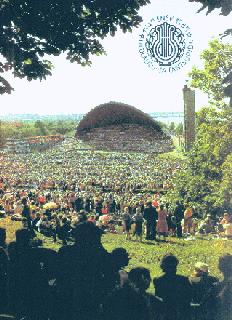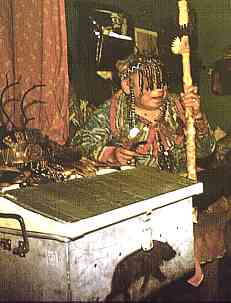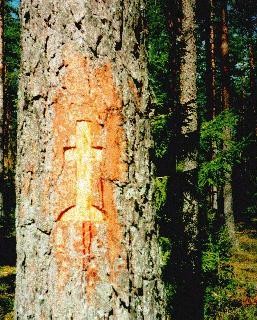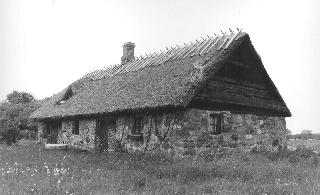 Kristin Kuutma
Kristin Kuutma Mall Hiiemäe
Mall HiiemäeClassification of Beliefs by an Astronomer
Enn Kasak Aado Lintrop
Aado Lintrop Marju Kõivupuu
Marju KõivupuuSong Festivals as the Carriers of National Identity
 Kristin Kuutma
Kristin Kuutma
The basis of wider distribution of choral singing among the country people was established at school and in the church. At the beginning of the 1930s, the development of polyphonic choral singing started. The example of choral singing as a form of social activity was taken over from the Baltic Germans among whom a movement of choral societies cultivating polyphonic men- or mixed choruses was widespead on direct influence of German culture. In Germany it was one expression of the national need of Germans to become one nation. In Estonia, in Põlva already in 1855 and 1857 several choruses performed together on what was called a "song-holiday", but the first song-holiday of a county that had a wider response was organised by the local priest Martin Köber in 1863 in Anseküla, where 500 singers participated. In North-Estonia, the first song festival was held two years later in Jõhvi, and in June 1869 the first Estonian nationwide song festival was held in Tartu after two years of pursuing a permission from the authorities. It has been even claimed that Estonians sung themselves into a nation. Since then, song festivals have regularly been taking place.
The song festival is a folk festival, being at the same time both a ritual and a spectacle. The song festival creates a situation where cultural identity and national unity can be demonstrated. The mechanism of this festival is social mobilisation, people come to the festival with their families and friends, more important than the choral experience is communicating with those from close and afar, the need to experience reblendation into the society in a wider sense, the sense of unity with the nation, its history and cultural heritage. Artistic organised performances taking place during the festival that are aimed at the audience demonstrate cultural devotions of the particular community, carrying at the same time three main purposes: the social function to organise the community; the psychological function to express personal and collective emotions; and thirdly, the function to expose, strengthen and create the particular culture (Turner-McArthur 1990, 86).
The song festival as a folk festival creates a communicative situation that actively includes all participants, giving a combination of the opportunity to participate and perform in social context. One motivation to take part in a folk festival is social interaction through which all kinds of relationships are arranged and cleared. Activities making up a folk festival reflect the interests of the given community, giving thus an opportunity to express definite ethinicism, which also brings about strengthening of self-consciousness, political action and revitalisation of the society. Folk festivals support regeneration of the society and organises the society's life, it strengthens the group's identity and ability to act in its own interest, thus helping to articulate social problems. Messages of the folk festival touch the group's common experience and its multilevel interpretation. A folk festival assembles the community, offering thus a picture of both the community and the individual's part in it (Stoeltje 1992). During the song festival, reblendation into the society in a wider sense, identification with the nation, its history and cultural heritage, are experienced. This cultural performance is at the same time a collective "text" of the particular society, a story of us as we are telling it to ourselves (Geertz 1973).
Izhorian Folk Music
Igor Tõnurist
According to the 1989 census, there are only a little more than 800 Izhorians. In contrast, 60 years ago there were more than 26 000 Izhorians. The deportations of 1937, the Second World War during which Izhorians, Votians, and also Ingrians were deported to Finland, and those who returned, further to the so-called expanses of the soviet fatherland. But despite all this, the ancient folklore traditions have not been broken and up to recent times, runo songs have still been recorded from amongst Izhorians and Votians.
Feodor Safronov was born in 1886 in the Viistna village on the Soikkola peninsula in Ingria. He died in 1962 in Helsinki where he had been living under the name Teppo Repo. He is one of the best Izhorian musicians.
The Izhorians played the buckhorn and willow-pipe. Instrumental imitation of lamentation was a part of the traditions of Izhorians, Russians, Lithuanians and even our Setus. Kävelukeppi was a long wooden willow-pipe, that had been wrapped into birch bark. It had no fingerholes and the height of sounds could be changed either by regulating the strength of blowing or by opening and closing the lowest finger-hole with a finger. This is similar to the long-pipe once known in Läänemaa. Kasetoht or birch-bark could be the musical instrument all north European nations have in common. In Ingria, also the bagpipe was known, but it was called rakkopill or bladder instrument because the windbag of the bagpipe was made of swine cyst. The zither is called kannõl by Votians and kannel by Izhorians. Even though the old Izhorian-Votian zithers looked exactly like the ones in Estonia or Karelia and Finland, they were held half-across the lap with the shorter side up, as the Russian stringinstrument-players used to do and still do. The zither was quite popular in some Izhorian and Votian villages at the beginning of the century. Despite the survival of the runo song, at the beginning go this century it were often already the Russian melodies that were danced and sung after. Even Estonian melodies were not unknown to the Izhorians. Estonian bagpipe-players participated in Votian weddings, also Estonian newer zithers and psalteries were played in the first half of the century. Although the concertina or garmon was the most common accompanying instrument, it was the zither that often accompanied village parties in the first half of the century.
Karoobotska is a Russian fashionable dance on from the beginning of the century that was also popular here in Setumaa. One of the best liked dance in Ingria was quadrille that consisted of many rounds, up to seven. Inbetween rounds, their names were called. The new concert-gusli, that was actually a representative of the co-operation of three nations - Izhorians, Russians and Estonians - became widely used all over Russia.
Sigmund Freud and Psychoanalytical Studying of Jokes
Astrid Tuisk
In psychological observations of jokes, it is not so much the text of the joke than the function and place it has in the person reading, telling, or listening to the joke that interest is taken in. The influence of the joke on him and what touches that individual is dealt with. In the psychoanalytical approach, jokes are viewed as an expression of the subconscious. This approach explains jokes from the viewpoint of the human soul. In his work Der Witz und seine Beziehung zum Unbewußten (Jokes and their Relation to the Unconscious), Sigmund Freud pays attention mostly to the context of the material, coming to the conclusion that every narrative influences the human soul differently. In the latter, the difference of all humans lies in.
Freud differentiates the technique and tendency of jokes. The joke can be obscene, aggressive (hostile), cynic (critical or blasphemous) or sceptical by its tendency (function) and emphasis. When talking about the three-link chain of interpreting jokes, the communicativity of jokes is emphasized. Freud writes about the impossibility of laughing at a joke created by one as what becomes evident there touches the creator much too deeply. At the same time the joke can not be kept only to one's own knowledge, because the urge to tell it is too big. A joke can exist only in a communicative process.
One of the most significant representatives of the discipline, Gershon Legman, studies the favourite anecdotes of narrators in his book Rationale Of The Dirty Joke: An Analysis Of Sexual Humor. During an experiment, people are asked to tell their favourite anecdote or the joke they remember first. Then the jokes are analysed as this should throw light upon some of the hidden corners of the human psyche.
Psychoanalysis could develop only in modern society. It has been called a phenomenon of the contemporary chaos and also an attempt to turn everything upside down. But can an anecdote, already by its nature based on denial, be explained by another upside-down-turner? If, through jokes, it is possible to draw conclusions on their creator and the psyche of their users, then can we make hypotheses about which anecdotes that person probably likes, basing only on their psyche?
But the main task is still finding answers to the questions, what we are laughing at and why we laugh at the particular. When trying to characterise the surrealistic jokes of today, we should also think of Sigmund Freud and his work Der Witz und seine Beziehung zum Unbewussten.
Political anecdotes. I
Kadi Sarv
A political anecdote is first all, a popular and not a scientific concept. It is a forbidden story told only to those you trusted, who thought like the speaker did. This phenomenon characterises primarily a society of repression where people have no opportunities to express their dissatisfaction in a legal way.
Political subject is just as often found in conundrums as in anecdotes. For some subjects, it even seems that the conundrum expresses attitudes and opinions more colourfully and precisely than the anecdote. An old-fashioned anecdote, the longer style of delivery of which has been forgotten over time, may sometimes take on the form of a conundrum. The so-called introduction falls away and the colourful punch line of the anecdote is used in the new conundrum.
Political background may occur in anecdotes about persons, ethinics or animals.
Political anecdotes and conundrums can be divided into three groups:
1. Anecdotes and conundrums about statesmen. Typical subjects are a visit, competition or outdoing each other;
2. Anecdotes which poke fun at the socialist or communist system, but in which specific statesmen are not mentioned;
3. Anecdotes about life conditions, in which situations created by the crumbling system are described.
Most of the information used in this article originates from the collections of the Estonian Folklore Archive, especially from the collection of materials handed in during the children's competition of school traditions in 1992.
In the first part of the series of articles, an overview of political anecdotes at the time of the Estonian Republic (1920-1939).
The Hunter and His Song
A Hanti fairytale
Once upon a time there lived a hunter. One day he started to sing, but did not sing the song to the end. Then he sung the same song for another time but again could not finish it. And that was the way it stayed.
One day that hunter went out hunting. Walked for a long or a short while, and suddenly - such a blizzard came that nothing could be seen. He started to look for his house: searched, searched, but couldn't find it anyhow. He walked, walked some more, and suddenly saw - a püstkoda is standing not far away. But around it, a herd of elks is running. The man approached the house, stepped inside. The family was sitting there. The man was kindly asked to join them at the table, they drank tea and then they asked where he was coming from and how he happened to come to their place with such a blizzard. The man started to talk: "You see, I recently went out hunting. I went on and the storm blew up. These here seem to be familiar places, but I do not seem to be able to find my home. How did it come to happen like this? But where are you from, I think I have not seen you ever before?"_ "We, you see, got caught in this blizzard long ago. There is some kind of singer here.. all the time he sings a song of how the blizzard starts.. he never ends the song, always leaves it unfinished. And we, you see, got caught in his song. We have not been able to return home. You might be the guilty one. If you will sing your song to the end, you will see your home. If not, you will stay here with us forever."
The hunter had no other choice but to sing his song to the end. As soon as he finished his song, he woke up on a small hill near his house. There were no herdsmen, no elks, there was nobody around there. He went to his house and told the others about his adventures. And whenever he started to sing, he always sang his songs to the end, and whenever he started to tell a story, he always finished it. This is all, the tale's over.
Heard from Slava Pesikov from Ljantor village. Collected by Anzori Barkalaja.
Impressions from Läänemaa. Summer 1996
 (Paragraphs from the fieldwork-diary, extracts from the collected material)
(Paragraphs from the fieldwork-diary, extracts from the collected material)The EFA summer expedition of 1996 to the parishes of Martna and Kirbla was regarded with some prejudice and fears (the religious exorbitance in Läänemaa, the introversion of the local people, etc.), but all the more decisively. Soon it was clear that the locals were everything but introverted and religious movements were something I soon started to long for.
Quite soon I also got the impression that although there had been several musicians and good singers in that region (now we only managed to collect the basic data and memories of them) and very many still had song notebooks, there was no superstition or any narratives of the kind. For example: My father didn't believe. He did always the opposite. There in a village, it was that: "No, today morning it is no use going out, the horse dung between the shafts." my father still went, just out of stubbornness. But then there were still some who knew both legends of place names (this time very many about Kalevipoeg and Kuradikivi - 'Devilstone') and narratives with a rich religious background. (It is common knowledge that when looking for the oldest and natural born locals, the collector may not notice some really interesting people - just as almost by accident I found a woman born in 1947 whose grandfather had been a musician, mother a singer, who herself told of a treasure-bearer seen by her grandmother, of omens connected with herself, the birth of her son and the death of her mother and of many other things.)
It is interesting that quite some of the people who themselves had no other supernatural experiences had still just before the war either seen themselves some heavenly signs or had heard of them from someone close. In most cases the sky had been purple red in the east, but there were more concrete omens as well.
The rich bee-traditions of Läänemaa which have been recorded in the EFA cardfiles in the `30s, have by now lost most of its religious background. From the earlier local witches, mostly those who dealt with healing plants or fixed sprained bones were mentioned. The of attitudes towards the sensitives and healers of today in Läänemaa varied from severe criticism to deep respect.
This year, perhaps more material than usual was collected that could serve as a basis for the so-called background studies, that is, what people themselves talk of their life, conditions and how they feel about the way the world is, what they consider to be important, not only folkloristic material and remnants or signs of the primeval beginning of the things.